DELIVERING NATIONAL ECONOMIC INFRASTRUCTURE IN SOUTH AFRICA: A REVIEW OF STRATEGIC INTEGRATED PROJECT #3
Price
Free (open access)
Transaction
Volume
253
Pages
13
Page Range
135 - 147
Published
2021
Size
1,292 kb
Paper DOI
10.2495/SC210121
Copyright
Author(s)
DEENA GOVENDER
Abstract
The South African (SA) government has for many years pursued much needed social and economic transformation. This journey is far from a path void of obstacles and complicated challenges. However, the significance of providing economic and social infrastructure is one of the strategies prioritised by government to enable entrepreneurship, employment opportunities, access to essential services by the poor, and empower people through education and skills development. In this regard, to address critical socio-economic challenges in SA, in 2012, the Government adopted a National Infrastructure Plan (NIP) supportive of the SA National Development Plan (NDP) imperatives. The vision of the NIP is to transform the economic landscape through the implementation of strategically integrated infrastructure projects. The NIP strategy foresaw economic sustainability for the future and an improved standard of living for many impoverished communities in SA. In this light, and in support of the NIP vision, the Presidential Infrastructure Coordinating Commission (PICC) was established to integrate and coordinate the original eighteen Strategic Integrated Projects (SIPs). SIP projects were selected based on their catalytic nature and grouped into several infrastructure programs (SIP-1 to SIP-18). In January of 2013, the Minister of Water and Environmental Affairs formally directed the Trans-Caledon Tunnel Authority (TCTA) to take-up the program coordination role for SIP-3. This study is to better understand the SIP-3 Coordination function and performance through a review of the SIP-3 program. The paper highlights a path through SIP-3 Coordination experiences from its inception in 2012 to present (2021). The review is in line with, but not limited to, the SIP-3 program business plan, the coordination function of SIPs, the intended and realised impact of the program. Lessons are drawn from the review outcomes and recommendations are made for improving national infrastructure development and coordination that is supportive of economic and social advancement in South Africa.
Keywords
South Africa, Infrastructure, Planning, Strategies, Social, Economic, sustainable





